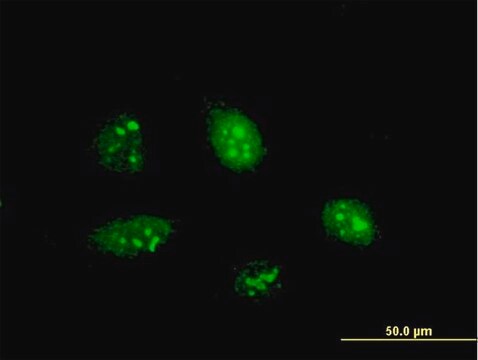ST1202
Anti-PGC-1α Mouse mAb (4C1.3)
liquid, clone 4C1.3, Calbiochem®
Sinônimo(s):
Anti-Peroxisome Proliferator-Activated Receptor- γ Coactivator 1 α
About This Item
Produtos recomendados
fonte biológica
mouse
Nível de qualidade
forma do anticorpo
purified antibody
tipo de produto de anticorpo
primary antibodies
clone
4C1.3, monoclonal
forma
liquid
não contém
preservative
reatividade de espécies
mouse, human, rat
fabricante/nome comercial
Calbiochem®
condição de armazenamento
OK to freeze
avoid repeated freeze/thaw cycles
Isotipo
IgG
temperatura de armazenamento
−70°C
modificação pós-traducional do alvo
unmodified
Informações sobre genes
human ... PPARGC1A(10891)
Descrição geral
Imunogênio
Aplicação
Immunocytochemistry (5-10 µg/ml)
Immunoprecipitation (10 µg/ml)
Paraffin Sections (whole mount) (see application references)
Advertência
forma física
Reconstituição
Outras notas
Rodgers, J.T., et al. 2008. FEBS Lett. 582, 46.
Mazzucotelli, A., et al. 2007. Diabetes 10, 2467.
Nemoto, S., et al. 2005. J. Biol. Chem. 16, 16456.
Informações legais
Não está encontrando o produto certo?
Experimente o nosso Ferramenta de seleção de produtos.
Código de classe de armazenamento
10 - Combustible liquids
Certificados de análise (COA)
Busque Certificados de análise (COA) digitando o Número do Lote do produto. Os números de lote e remessa podem ser encontrados no rótulo de um produto após a palavra “Lot” ou “Batch”.
Já possui este produto?
Encontre a documentação dos produtos que você adquiriu recentemente na biblioteca de documentos.
Nossa equipe de cientistas tem experiência em todas as áreas de pesquisa, incluindo Life Sciences, ciência de materiais, síntese química, cromatografia, química analítica e muitas outras.
Entre em contato com a assistência técnica







